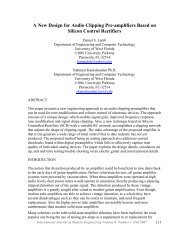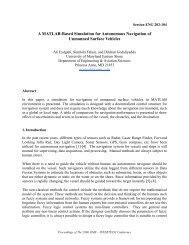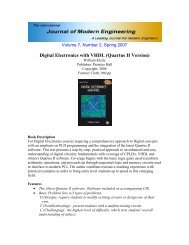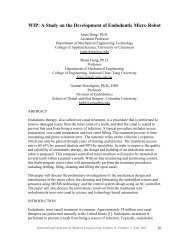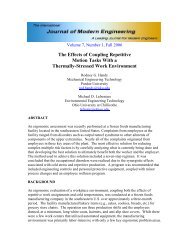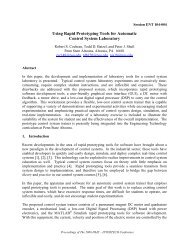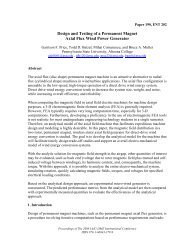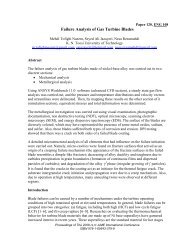ENT 108-099 - IJME
ENT 108-099 - IJME
ENT 108-099 - IJME
You also want an ePaper? Increase the reach of your titles
YUMPU automatically turns print PDFs into web optimized ePapers that Google loves.
Section <strong>ENT</strong> <strong>108</strong>-<strong>099</strong><br />
Algorithmic Complexity Measure and Lyapanov matrices of the<br />
Dynamical Systems<br />
Davoud Arasteh<br />
Department of Electronic Engineering Technology<br />
Southern University, Baton Rouge, LA 70813<br />
davouda@engr.subr.edu<br />
Abstract<br />
The problem of distinguishing order from disorder in dynamical systems can be answered by<br />
certain quantities such as Lyapanov exponents, fractal dimensions, power spectrum density, and<br />
algorithmic complexity measures. In this paper, we have compared two approaches to evaluate<br />
the order and disorder in dynamic systems behavior. First, this is done by mapping the system<br />
output signal to a binary string and calculating the complexity measure of the time-series data.<br />
The results from algorithmic complexity are compared with the results from Lyapunov metrics<br />
computation. Using these two metrics, we can distinguish noise from chaos and order. This is<br />
important because modern engineering disciplines deal with signals acquired in the form of time<br />
series. The signals obtained from biological, electrical or mechanical systems appear to be<br />
complex. Therefore by extracting their characteristic features in such processes, one can make a<br />
correlation to a certain class of perception or behavior in cognitive sciences. This can be used for<br />
better analysis, control and diagnosis.<br />
Introduction<br />
In this paper we have addressed two practical approaches to evaluate the order and disorder in<br />
nonlinear systems output signal using algorithmic complexity measure [1,2,3] and largest<br />
Lyapanov exponent [4,5]. Mapping the system output signal to a binary string and calculating the<br />
complexity measure of the time-series data, does the characterization of strange attractors by the<br />
pattern formation in phase space attractors. The results obtained from complexity measure are<br />
compared with the results from Lyapunov metrics computation. In nonlinear chaotic systems<br />
small changes in initial conditions lead eventually to large changes in the behavior of the system.<br />
Nevertheless the system remains stable due to its deterministic nature, this occurs because the<br />
chaotic attractors with fractal geometry are confined in a certain region in phase space. For<br />
example in neural systems the divergence from initial state is the fundamental characteristics of<br />
perception to distinguish very close perceptual entities. The artificial cognitive informatics is<br />
concerned with the extraction of characteristic features, their measurement and characterization<br />
of phase space patterns in the processes related to perception and cognition. Signals obtained<br />
from such processes like EEG, ECG or behavioral signals appear to be random. Despite the fact<br />
that, these signals are not random and can be classified as chaotic [6,7,8,9,10]. There are several<br />
metrics to measure chaos, depending on what one wants to characterize in the chaotic trajectory.<br />
Certain quantities such as Lyapanov exponents, fractal dimensions, K-entropy, algorithmic<br />
complexity and power spectrum analysis have been used as screening tools to detect chaos in<br />
nonlinear systems. But methods like Fourier transform, and the resulting power spectrum<br />
Proceedings of The 2006 <strong>IJME</strong> - INTERTECH Conference
density, fails to distinguish between chaos and noise, because both phenomena are broadband.<br />
This paper deals with the fundamental concept of measuring chaos in dynamical systems through<br />
algorithmic complexity measure and Lyapanov exponents. Algorithmic complexity is a useful<br />
practical tool to characterize spatiotemporal patterns of nonlinear dynamical systems. Both<br />
metrics are capable of distinguishing chaos from order but only complexity metric is capable of<br />
distinguishing deterministic chaos from random noise. In the next section, we introduce the<br />
concept of algorithmic complexity.<br />
Mathematical background<br />
Algorithmic complexity theory defines randomness based only on the characteristics of the<br />
signal, without any knowledge of the source of the data. Application of algorithmic complexity<br />
in multi-dimensional discrete and continuous dynamical systems as a characterizing parameter is<br />
discussed in [11]. We have used Henon discrete map, and forced-dissipative oscillator system to<br />
exemplify and illuminate the concept. We will see that for continuous nonlinear dynamical<br />
system algorithmic complexity measure is as powerful as other characteristics like spectrum of<br />
dimensions and entropies. The numerical effort needed to extract these spectra is rather large.<br />
This limits their determination to systems with dimensionality lower than ten. Therefore it is<br />
necessary to develop analytical tools in order to characterize chaotic motion in high-dimensional<br />
dynamical systems, e.g. spatiotemporal turbulence, or poorly stirred chemical reactions.<br />
The algorithmic complexity of a string is defined to be the length in bits of the shortest algorithm<br />
required for a computer to produce the given string. For our purposes it is not necessary to assign<br />
an absolute value for the complexity of a string of bits. This means relative values are always<br />
sufficient. The shortest algorithms are referred to as minimal programs. The complexity of a<br />
string is thus the length in bits of the minimal program necessary to produce the given string. The<br />
definition of a random number can now be given as any binary string whose algorithmic<br />
complexity is judged to be essentially equal to the length of the string. Qualitatively, the<br />
information embodied in a random number cannot be reduced or compressed to a more compact<br />
form. As the string S grows in length, the length of program grows like n, and the length of the<br />
computer program in bits is essentially the same as the length of S. Such a string satisfies the<br />
definition of a random number since the algorithmic complexity of the string is essentially the<br />
same as the length in bits of the string.<br />
One of the major challenges in chaotic dynamics is to extract a meaningful signal from data that<br />
have every appearance of being random. Clearly algorithmic complexity is a concept aimed<br />
specifically at the problem of distinguishing between the random and the nonrandom.<br />
Nevertheless it can distinguish between chaotic, quasi-periodic, and periodic signals. The<br />
problem lies in determining a computable measure of complexity. No absolute measure is<br />
possible because minimal programs by definition correspond to random numbers, and it is not<br />
possible to determine a truly random number in any formal system. Nevertheless, it is possible to<br />
define a measure of complexity. A relative measure is sufficient for many purposes. For the first<br />
time Kasper and Schuster applied this idea to dynamic systems exhibiting chaos based on work<br />
of Lempel and Ziv. The measure of complexity introduced by Lempel and Ziv is referred as LZ<br />
complexity for brevity. The LZ complexity measures the number of distinct patterns that must be<br />
copied to reproduce a given string. Therefore the only computer operations considered in<br />
constructing a string are copying old patterns and inserting new ones. Briefly described, a string<br />
S is scanned from left to right and complexity counter c (S) increased by one unit every time a<br />
Proceedings of The 2006 <strong>IJME</strong> - INTERTECH Conference
new sub-string of consecutive digits is encountered in the scanning process. The resultant<br />
number c (S) is the complexity measure of the string S. Clearly any procedure such as this will<br />
over estimate the complexity of strings, but nevertheless we expect comparisons to be<br />
meaningful.<br />
Our efforts here are directed toward outlining a computational algorithm and giving examples of<br />
the LZ complexity measure for various dynamic systems. In quantifying these ideas it becomes<br />
necessary to introduce certain definitions. Let A denote the alphabet of symbols from which the<br />
finite length sequences S are constructed and denote the length of these sequences as L (S) = n.<br />
A sequence S may be written in the form S = S1S2S3...Sn, where Si is mapped from phase space<br />
attractor pattern of a dynamic system based on a mapping rule. The vocabulary of a sequence S,<br />
denoted by V (S), is the set of all substrings of S. The LZ complexity of a given string S is the<br />
number of insertions of new symbols required to reconstruct S, where every attempt is made to<br />
construct S by copying alone without inserting any new symbols. The process is iterative and the<br />
first symbol must always be inserted. Notice that the minimum value for LZ complexity is two.<br />
Furthermore the LZ complexity measure for a given string S is unique and only relative values of<br />
c (n) are meaningful. In particular it is the comparison with the complexity of the random string<br />
that is meaningful. That is one should always compare the LZ complexity of a given string to the<br />
LZ complexity of random strings of the same length, lim n→∞ [c (n)/b (n)], where for a random<br />
string of length n, the LZ complexity is given by b (n) = n/log 2 (n). Fig. 1 shows the complexity<br />
measure calculation flowchart.<br />
Results<br />
The usefulness of the algorithmic complexity measure as a characteristic metrics in dynamic<br />
systems to distinguish the order from disorder is studied next. In this approach, the phase space<br />
pattern of a certain nonlinear system is mapped to an array of symbols. Then the algorithmic<br />
complexity of the resulting bit string is calculated. Our first example is a famous discrete map<br />
called Henon map. The Henon map is a prototypical 2-D invertible iterated dynamical with<br />
chaotic solutions proposed by the French astronomer Michel Henon in 1976 [12]; as a simplified<br />
model of the Poincare map for the Lorenz model. In 1963 the meteorologist Edward Lorenz<br />
observed that a dynamical system with three coupled first-order nonlinear differential equations<br />
could lead to completely chaotic trajectories [13]. Non- linearity is a necessary, but not sufficient<br />
condition of chaos. It is necessary condition, because linear differential equations can be solved<br />
by Fourier transform procedures and do not lead to chaos. The system Lorenz used to model the<br />
dynamics of weather differs from Hamiltonian systems mainly by its dissipativity.<br />
Proceedings of The 2006 <strong>IJME</strong> - INTERTECH Conference
Start<br />
(String<br />
length N)<br />
C=1<br />
L=1<br />
I=0<br />
K=1<br />
K MAX =1<br />
S(I+K)=S(L+K)<br />
YES<br />
K=K+1<br />
NO<br />
(I+K)>N<br />
NO<br />
S (I+K)=S(L+K)<br />
NO<br />
YES<br />
K MAX =K<br />
C=C+1<br />
YES<br />
I=I+1<br />
END<br />
I=L<br />
YES<br />
K=1<br />
NO<br />
YES<br />
C=C+1<br />
L=L+KMAX<br />
(L+1) > N<br />
NO<br />
Figure 1<br />
Flowchart for calculating LZ complexity for string S with length N<br />
A dissipative system is not conservative but “open”, with an external control parameter that can<br />
be tuned to critical values causing the transitions to chaos. Henon map can illustrate the basic<br />
concepts of complex dynamical systems from non-linearity to chaos with rather simple<br />
computer-assisted methods. Henon map is defined by following quadratic (nonlinear) recursive<br />
map: X n+1<br />
= 1 - a X n<br />
2<br />
+ Yn , Y n +1 = b X n<br />
Where 0
is increased further beyond a critical value a 3 =1.05, the period length doubles. If “a” is increased<br />
further and further; then the period doubles each time with a sequence of critical values a 2 , a 3 .<br />
But beyond a critical value a, the development becomes more and more irregular and chaotic.<br />
For these values, the mapping is contracting the area and has a trapping region, so it exhibits an<br />
attractor. However, for all values |b|
Figure 2<br />
The LZ complexity of strings constructed from the Henon map as a function of<br />
control parameter “a”<br />
Figure 3<br />
Henon bifurcation diagram vs. control parameter “a”.<br />
Figure 4<br />
Largest Lyapunov exponent as a function of control parameter “a”<br />
Proceedings of The 2006 <strong>IJME</strong> - INTERTECH Conference
Our next example is a continuous dynamical system called Forced-Dissipative-Oscillator. It is<br />
used as a mathematical model for many physical and engineering systems like forced-dissipative<br />
pendulum and Josephson junction under microwave radiation [14, 15, 16], given by following<br />
dynamical equation: D 2 X+ k(DX) + Sin X = g Cos ( d<br />
t), DX = dX/dt<br />
Control parameters are; “k” as system dissipative coefficient, “g” as external driving force<br />
amplitude, and d<br />
external driving force frequency. Roughly speaking, a dissipative system is not<br />
conservative but “open”, with an external control parameter that can be tuned to critical values<br />
causing the transitions to chaos. More precisely, conservative as well as dissipative systems are<br />
characterized by nonlinear differential equations dx/dt = F (x, G) with a nonlinear function F of<br />
the vector x = (x1, ..., xd) depending on an external control parameter G. While for conservative<br />
systems the volume elements in the corresponding phase space change their shape but retain their<br />
volume in the course of time, the volume elements of dissipative systems shrink as time<br />
increases. In dissipative system, or non-Hamiltonian systems, the area-preserving principle does<br />
not apply. In fact, the sum of all the Lyapunov exponents must be negative for physical<br />
dissipative dynamical system. A one-dimensional map like logistic map there is only one<br />
Lyapunov exponent. If it is negative, the map has either limit point stability or limit cycle<br />
stability. In n-dimensional systems, the stretching and contraction along the principal axis in the<br />
phase space produce a spectrum of Lyapunov exponents. For example in three-dimension the<br />
Lyapunov spectrum is (λ1, λ2, λ3). Stable periodic attractors have only zero and negative<br />
Lyapunov exponents. For example, (λ1= 0, λ2= negative number, λ3 = negative number) where<br />
the zero corresponds to the limit-cycle trajectory itself or (λ1= 0, λ2 = 0, λ3 = negative number)<br />
for an attracting 2-torus. Chaotic attractors have just one finite positive Lyapunov exponent. In<br />
three-dimension systems the spectrum of the Lyapunov exponents is (+, 0, -), where the zero<br />
corresponds to the chaotic trajectory itself, with some trajectories expanding, while others are<br />
contracting. For forced oscillator system we have used both tools to explore the regions of<br />
periodic and chaotic behaviors.<br />
The complexity of the oscillator map is calculated by setting control parameters to following<br />
values. d<br />
= 2/3, k = 0.5, and g is varied in the range [0.9, 1.5], with ∆g = 0.001. An array from<br />
n= 20000 iterations is constructed after removing the transient values for a specific external force<br />
amplitude (g). A digit “1” is mapped into the array if the velocity (DX) of the oscillator is larger<br />
than zero (a pendulum passing its equilibrium state), otherwise digit “0” is inserted in the array.<br />
The choice of using this encoding scheme is based on the symmetrical velocity distribution<br />
function. This function is calculated from distribution density of 80000 phase space points of a<br />
chaotic attractor (Fig. 5), with normalized frequency of 2/3, dissipation coefficient of 0.5, and<br />
external driving amplitude of 1.2. We have computed the algorithmic complexity measure of<br />
each experiment versus the corresponding driving force amplitudes (Fig. 6). For comparison we<br />
have also plotted the bifurcation diagram (Fig. 7) as well as the largest Lyapunov exponent (Fig.<br />
8). The results indicate distinct regions corresponding to chaotic and periodic behaviors. When<br />
Forced-Dissipative-Oscillator system has periodic behaviors of 1-cycle, 2-cycle, … and<br />
displayed in bifurcation windows, the LZ complexity measure is small. This corresponds to the<br />
limit-cycle trajectory or an attracting 2-torus. On the other hand chaotic attractors with some<br />
trajectories expanding, while others are contracting, have large LZ complexity, this is nicely<br />
mirrored by the increasing values of c (n) plot. For this system there is only one finite positive<br />
Lyapanov exponent and only one symbolic Lyapanov spectrum of the form (+, 0, -), where the<br />
zero corresponds to the chaotic trajectory itself, with some trajectories expanding, while others<br />
Proceedings of The 2006 <strong>IJME</strong> - INTERTECH Conference
are contracting.<br />
Figure 5<br />
Forced-dissipative oscillator strange attractor and its Poincare map<br />
g=1.2, k=0.5, ω d =2/3<br />
Figure 6<br />
Forced-Dissipative-Oscillator algorithmic complexity measure versus control<br />
parameter g, amplitude of the external force (0.9
Figure 7<br />
FDO bifurcation diagram versus control parameter g, amplitude of the external<br />
force (0.9
experiment. We observed that the algorithmic complexity of the chaotic responses is much<br />
higher than periodic responses. In this work we showed the usefulness of LZ complexity<br />
measure as a metric to characterize the patterns of discrete and continuous dynamical systems<br />
with chaotic and periodic responses. This is important because it provides a computational metric<br />
to find and classify the complex patterns.<br />
References<br />
[1] A. Lempel, J. Ziv, “On the complexity of individual sequences”, IEEE Transaction in<br />
Information Theory Vol. IT-22, p. 75, 1976.<br />
[2] A. Lempel, J. Ziv, “Compression of Individual Sequences via Variable-Rate Coding”, IEEE<br />
Transaction in Information Theory, Vol. IT-24, NO. 5, 1978.<br />
[3] Torres ME and L. G. Gamero, “Relative Complexity Changes in Time Series using<br />
Information Measures”, Physica A, Vol. 286, Iss. 3-4, pp.457-473, Oct. 2000.<br />
[4] A. Wolf, J. B. Swift, H. L. Swinney, and J. A. Vastano, “Determining Lyapunov exponents<br />
from a time series”, Physica D, vol. 16, pp. 285–317, 1985.<br />
[5] W. Kinsner, “Characterizing Chaos Through Lyapunov Metrics”, IEEE Transactions on<br />
Systems, Man, and Cybernetics, Part C, Vol. 36, No. 2, 2006.<br />
[6] Szczepanski J, JM Amigo, E Wajnryb and MV Sanchez-Vives, “Application of Lempel–Ziv<br />
complexity to the analysis of neural discharges”, Network: Computation in Neural Systems, 14<br />
pp. 335–350, 2003.<br />
[7] Gonzalez Andino SL, Grave de Peralta Menendez R, Thut G, Spinelli L, Blanke O, Michel<br />
CM, Seeck M, Landis T., “Measuring the complexity of time series: an application to<br />
neurophysiological signals”. Hum Brain Mapp. 2000 Sep;11(1):46-57.<br />
[8] Watanabe TA, Cellucci CJ, Kohegyi E, Bashore TR, Josiassen RC, Greenbaun NN, Rapp PE.<br />
“The algorithmic complexity of multichannel EEGs is sensitive to changes in behavior”<br />
Psychophysiology, Jan;40(1):77-97, 2003<br />
[9] Jaeseung, J., Jeong-Ho C., Kim, S. Y. & Seol-Heui, H., “Nonlinear dynamical analysis of the<br />
EEG in patients with Alzheimer’s disease and vacular dementia”, Clin., Neurophysiol 18(1):58-<br />
67, 2001.<br />
[10] Huang L, Fengchi Ju, Enke Zhang, Jingzhi Cheng, “Real-time Estimation of Depth of<br />
Anaesthesia Using the Mutual Information of Electroencephalograms”, Proceedings of the 1st<br />
International IEEE EMBS Conference on Neural Engineering Capri Island. Italy March 20-22,<br />
2003.<br />
[11] F. Kasper, H.G. Shuster, “Easily calculable measure for the complexity of spatiotemporal<br />
patterns.” Physical Review A, Vol. 36, p. 832, 1987.<br />
[12] M. Henon, “A two-dimensional mapping with a strange attractor”, Comm. Math. Phys. Vol.<br />
50, p. 69, 1976.<br />
Proceedings of The 2006 <strong>IJME</strong> - INTERTECH Conference
[13] E. N. Lorentz, ”Deterministic Nonperiodic Flow”, J. Atoms Sci., Vol. 20, p.130, 1963. In<br />
“Universality in Chaos”, edited by P. Civitanovic, Adam Hilger, 1989.<br />
[14] C. B. Whan and C. J. Lobb, “Complex Dynamical Behavior in RLC-shunted Josephson<br />
Junctions”, IEEE Transaction on Superconductivity, Vol. 5, No. 2, June 1995.<br />
[15] D. D’ Humierres, M. R. Beasley, B. A. Libchaber, “Chaotic states and routes to chaos in the<br />
forced pendulum”, Physical Review A, Vol. 26, No. 6, p. 3483, 1982.<br />
[16] B.A. Huberman, J. P. Crutchfield, N. H. Packard, “Noise phenomena in Josephson<br />
Junction”, Applied Physics Letter, Vol. 37, 750, 1980.<br />
Biography<br />
Davoud Arasteh serves as an assistant professor of Electronic Engineering Technology at<br />
Southern University of Baton Rouge. His research interests include Mobile Computing, Network<br />
Security, Nonlinear Dynamical Systems, Computer Vision, and Technology Based Engineering<br />
Education. He is the chair of departmental curriculum committee and is a member of ASEE,<br />
IEEE, IEEE Computer Society, IEEE Electromagnetic Compatibility Society, and IEEE<br />
Computational Intelligence Society.<br />
Proceedings of The 2006 <strong>IJME</strong> - INTERTECH Conference



